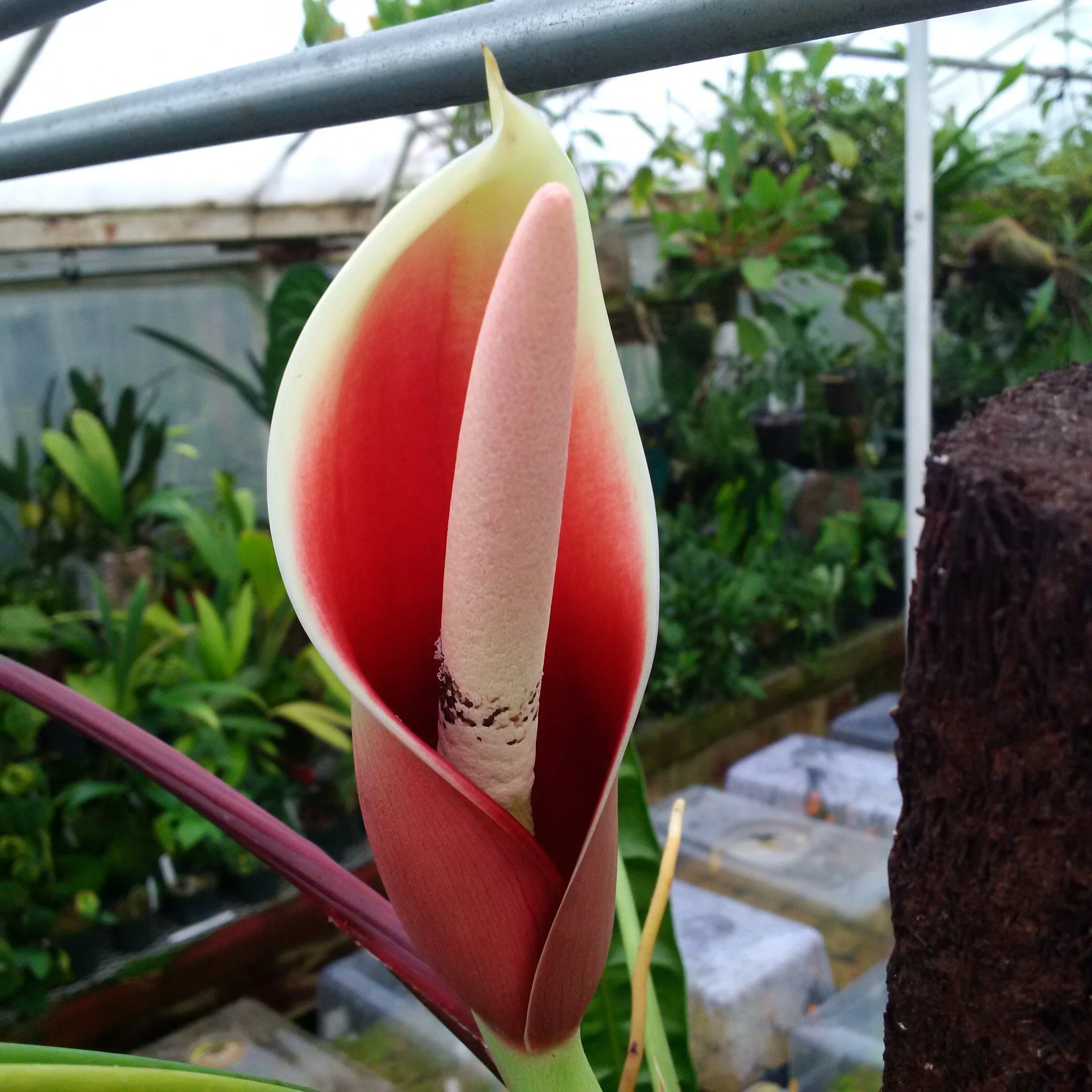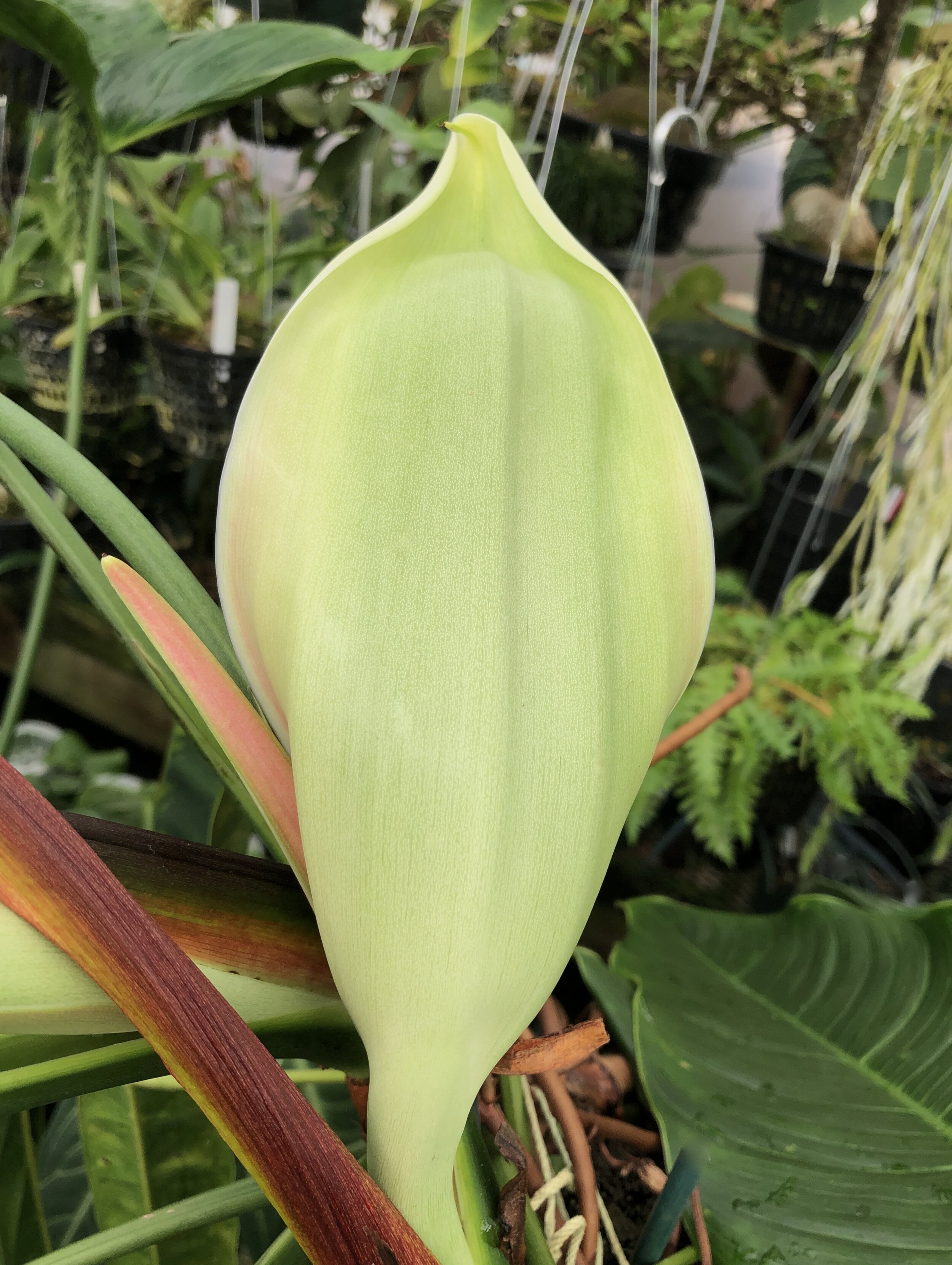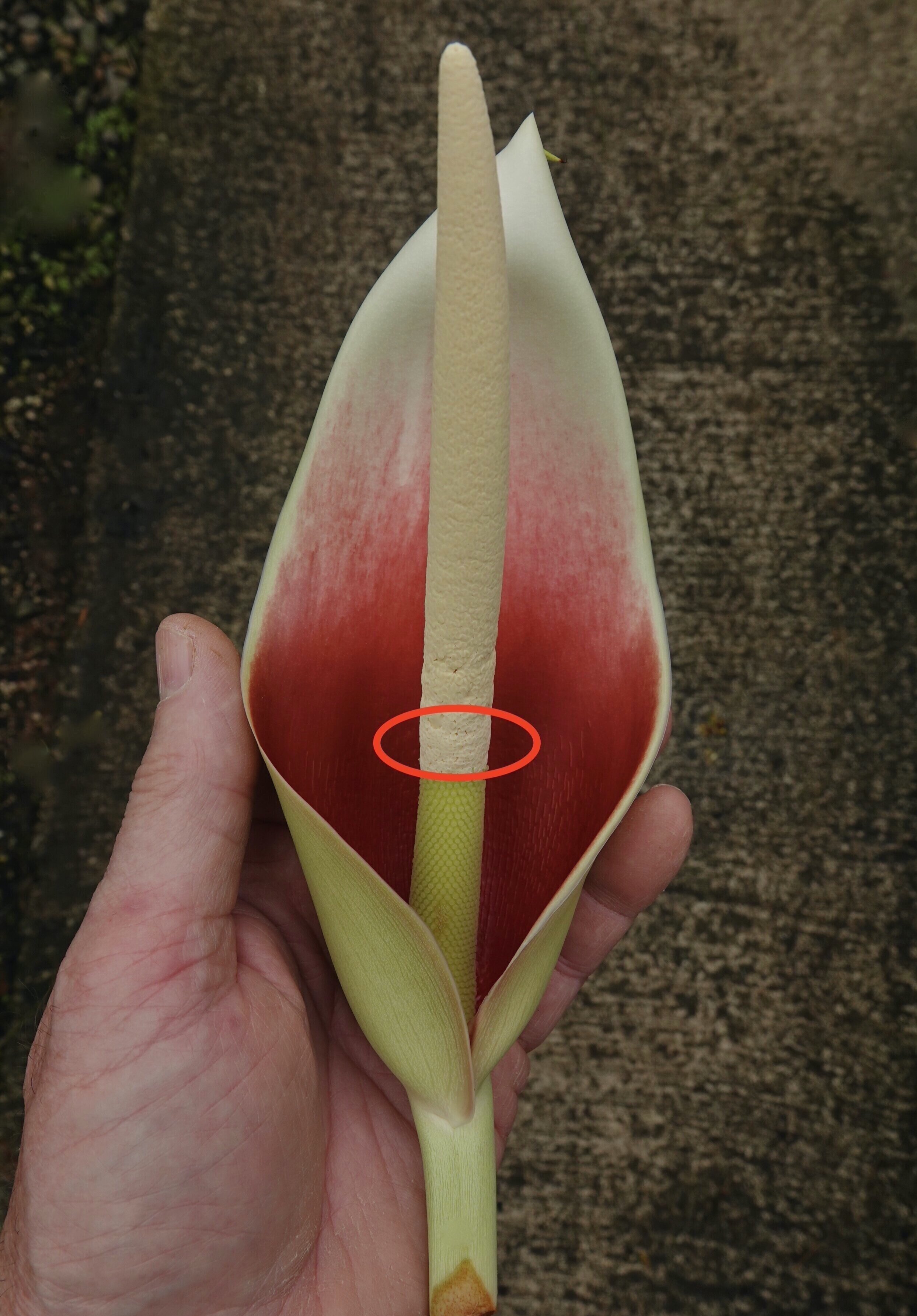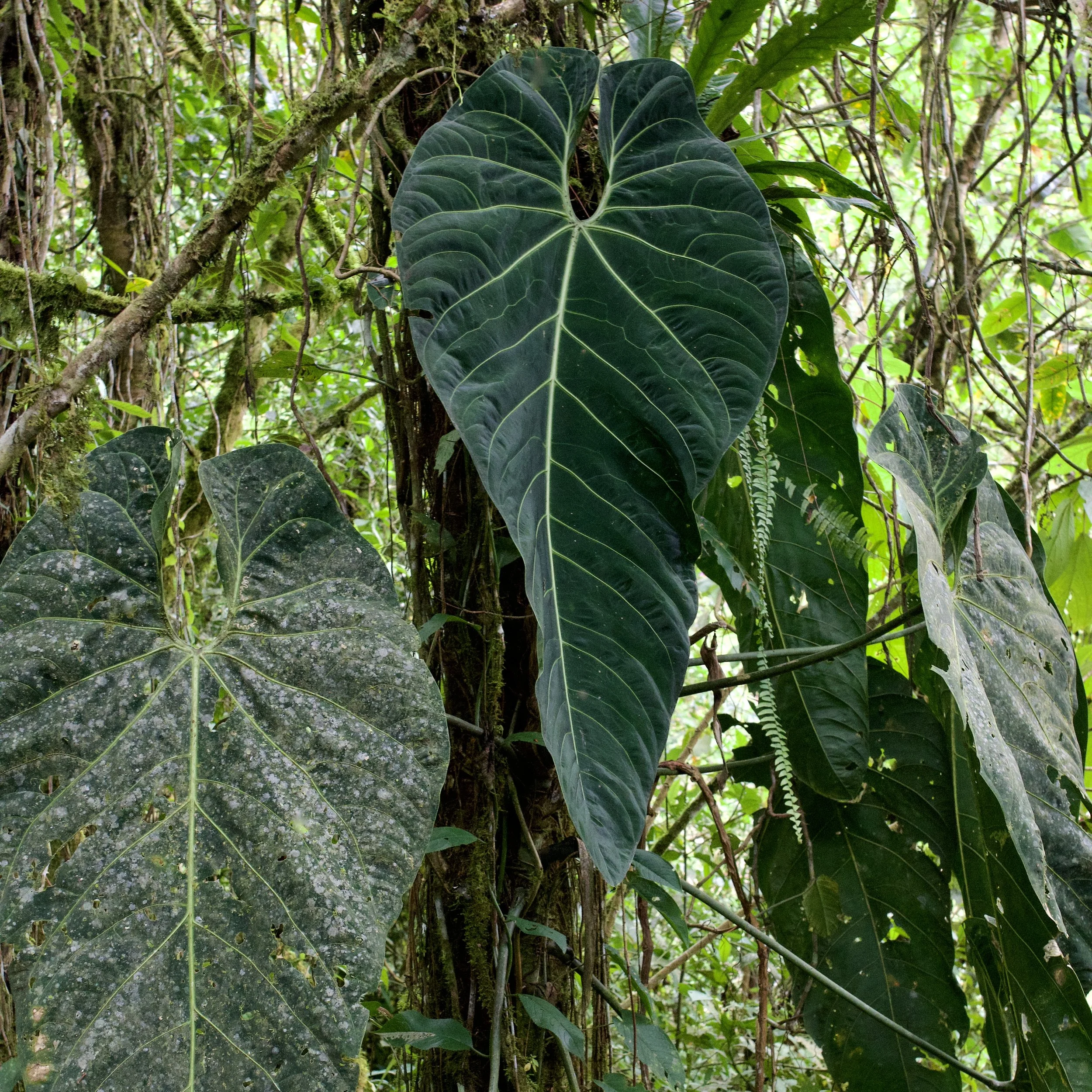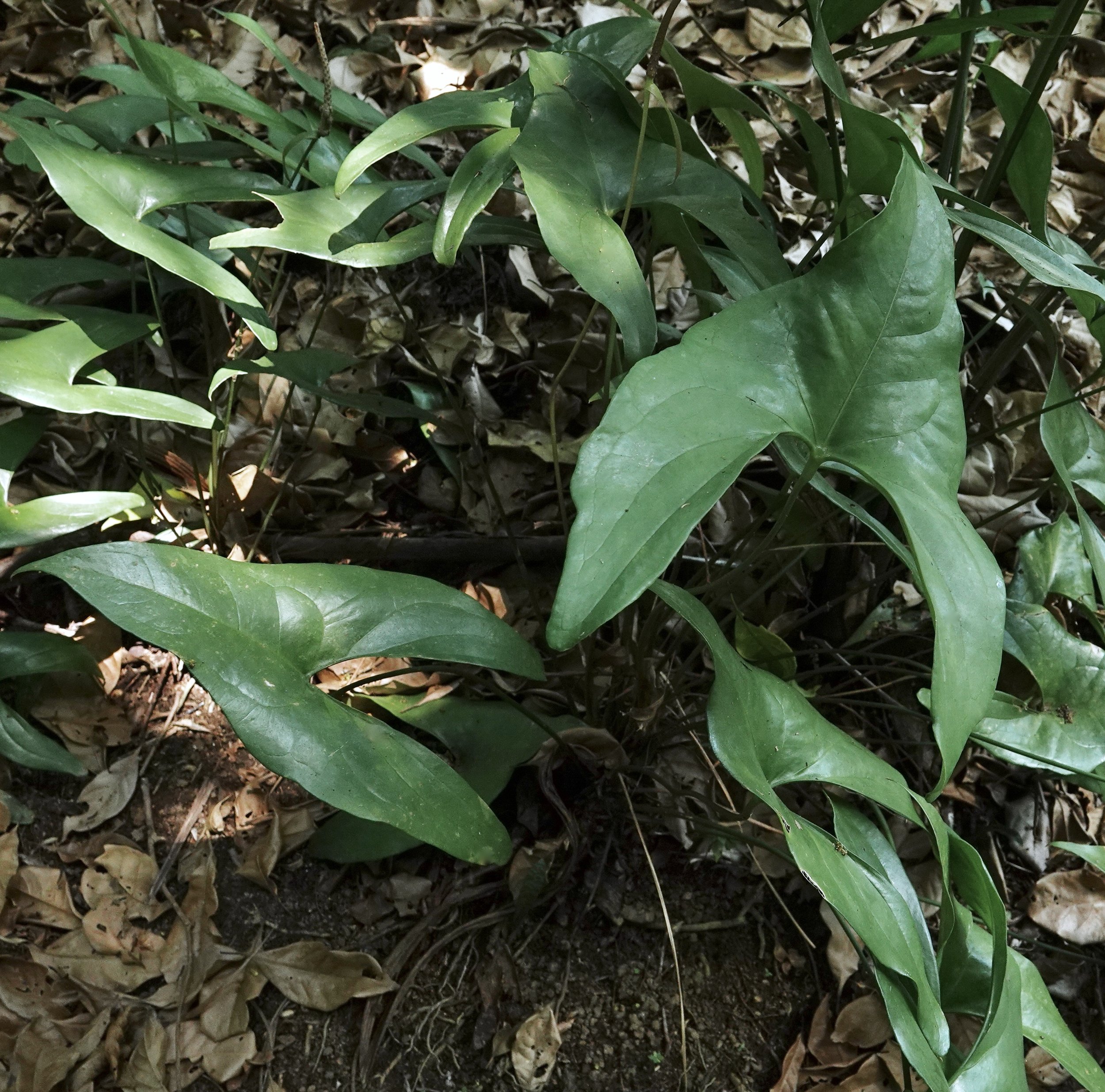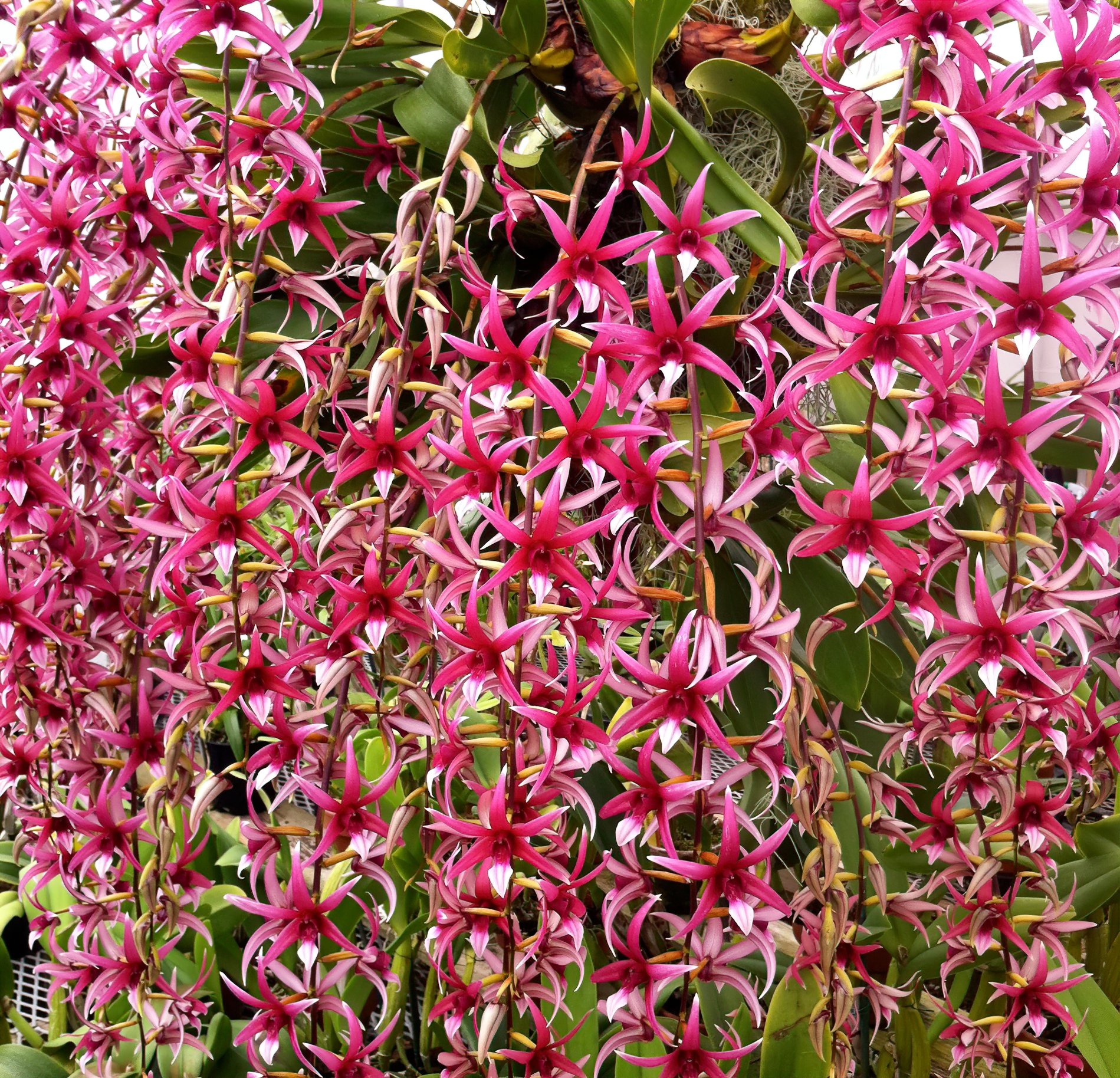Philodendron patriciae
“THE STUFF THAT DREAMS ARE MADE OF”
by Jay Vannini
A 2006 vintage wild origin Philodendron patriciae flowering in the author’s California collection showing the leaf characters that make this one of the most desirable of all cultivated aroids. Largest leaves shown here are 38”/97 cm x 9”/22 cm. Note leaf proportions (total length as multiple of width across broadest part of the lamina), subcordate leaf bases and obscure veination that identify this species. A mature P. gardeniodorum leaf is visible on the extreme right.
Mature leaf detail on a Philodendron patriciae in the author’s California collection.
For rare tropical foliage plant collectors and public gardens with rainforest-themed conservatories, few epiphytic plants are as coveted for display as the rare, large Philodendron and Anthurium species with long, heavily textured leaves. As botanical exploration of the rainforests of Panamá, Colombia, Venezuela, Perú and Ecuador yield new aroid treasures every year, several recently described forms stand out for their exceptional appearance and amenability to cultivation.
Without a doubt, the finest of these “new” ornamental tropicals is Philodendron patriciae. This pendent leaf aroid is a truly magnificent plant from a genus populated with plenty of rock star competition. Photos cannot really do justice to a well grown mature specimen when in flower, with a full complement of 20-30 long, rippled, sub velvety dark green leaves that drape straight from their petioles and the very showy porcelain white-edged light pink to crimson spathes.
The earliest documented flowering collection of this species was made in 1979 by the acclaimed botanist Alwyn Gentry (d. 1993) and companion Enrique Rentería in the Chocó Department of Colombia. Gentry was a researcher at the Missouri Botanical Garden (MBG) when he collected this specimen.
Following this discovery, Philodendron patriciae was recollected in nature by several other botanists associated with the MBG during the 1980s and 1990s, most notably including Thomas Croat, Barry Hammel and Michael Grayum. In 1984, Dr. Croat and Adrian Juncosa first succeeded in collected living material of this species that was originally intended for ex-situ study from high canopy in degraded forest near Quibdó in the Chocó. Unfortunately, a late decision by the junior collector led to this accession being converted to a preserved specimen (Juncosa 2580; T. Croat pers. comm.).
After that unsuccessful attempt to establish it in a botanical garden, the first live plant in cultivation outside of Colombia appears to have originated from a 1986 wild accession that was grown on for a time at Marie Selby Botanical Garden in Sarasota, Florida (Grayum 7650).
Claims made by some commercial plant collectors that they first introduced this species to cultivation in the 1990s apparently overlook earlier live collections made by the MBG staff and associated researchers.
For many years this plant was informally called Philodendron splendidum by Dr. Croat and, under that binomial, achieved almost legendary status among rare tropical plant collectors as the most enigmatic and desirable of the world’s aroids. Older ex-Tropicos images taken in nature by him in 1983 still circulate on the internet under this name.
Having been advised that another regional aroid specialist intended to use the epithet splendidum for a Brazilian Philodendron species, Dr. Croat opted to name it after Patricia, his wife of (now) 50 years. After giving a brief summary of the potential naming conflict – which by the way, has yet to materialize – and acknowledging Patricia’s unflagging support over much of a lifetime he concluded:
“This beautiful new species is a tribute to her many efforts on behalf of aroid research.”
Thus, after almost two decades delaying publication due to not having collected the fully developed inflorescences required for a complete description, Philodendron patriciae was described in Willdenowia in 2010 by Thomas Croat as part of a series of diagnoses of novel Colombian aroid taxa in collaboration with Xavier Delannay and Carla Kostelac. The holotype and several isotypes were vouchered from a large, wild origin plant cultivated at the Huntington Botanical Garden in California by the Curator of Tropical Collections there, Dylan Hannon (Croat et al. 2010, Hannon 2014).
Two wild origin Philodendron patriciae grown outdoors under polycarbonate in the author’s Guatemalan collection with younger individual visible lower right. These plants, while under cover, were frequently exposed to quite cold nights during the winter and emerged unscathed.
The name change was, in retrospect, a *splendid* decision. Dr. Croat, one of the world’s top living tropical floral field researchers and botanical taxonomists and who certainly knows a thing or two about elusive, beautiful aroids, also wrote in the description, “As an adult plant the species is one of the most attractive species in the genus.”
Need I say that I concur?
This species is currently placed in subgenus Philodendron, section Philodendron and subsection Canniphyllum. In the description, Croat compared it to P. rhodospathiphyllum (Croat & Bay 2008), but that species differs in having much shorter spreading leaves clustered apically on the stem, leaf lamina that are rounded at the base and not subcordate as in mature P. patriciae, and up to four small inflorescences per leaf axil.
As is the case in other scandent aroid genera, Philodendron species often undergo major ontogenetic changes in their foliage types, with juvenile leaves sometimes bearing little resemblance to mature leaves. Younger P. patriciae share more than a passing similarity to some young P. heterocraspedon, P. scherberichii and a couple of apparently undescribed pendent leaf philodendrons from southern Colombia and northern Ecuador, although the obscure secondary leaf veins and pleating on leaf lamina in P. patriciae are good key characters from early on.
More on the potential pitfalls of acquiring younger examples of these visually similar plants from commercial sources later in the article.
A windfallen juvenile Philodendron sp. cf. scherberichii making a go of it on the forest floor of lowland tropical rainforest near the type locality for P. heterocraspedon in Valle del Cauca Department, Colombia. This site houses plants that are extremely variable in leaf width and overall aspect and almost certainly includes two or more closely related species. Image: F. Muller.
This remarkable giant aroid grows as a hemiepiphyte from shady understory into emergent canopy at elevations of 300’/90 masl to at least 1,500’/465 masl. Leaves grow to over 48”/1.25 m in length and to 11”/28 cm wide in large mature plants. Unless greenhoused, most cultivated examples will have leaves under 30”/75 cm long x 5”/13 cm wide. These plants can carry a full head of foliage when well-cultivated, and mature leaves are extremely long lasting (three years+) on healthy specimens. Inflorescences on exceptional cultivated plants, which emerge one or two per leaf axil, are substantially larger than those reported in wild plants; one of my nicest specimens regularly produces very striking 10”/25 cm spathes on terminal leaf axils.
Documented collections originate from the southwestern Chocó Department of Colombia in the vicinity of the Quibdó and Lloró municipalities. Images of large wild plants posted on social media sites during the summer of 2019 were taken in forest relics between these two locations. This area experiences 40’/12.20 m (!!!) of rainfall annually. It is one of the wettest areas on earth and is one of only a handful of extant pluvial tropical rainforest ecoregions. Documented biological diversity and local endemism in this area is staggering and large numbers of new and noteworthy plant species occurring there await discovery or formal description (Croat, pers. comm).
Imported Philodendron patriciae began to appear very sporadically in the commercial exotic plant trade in the U.S. in the mid-2000s. Sprouted, bare-root stems were occasionally available from South American sources throughout the later 2000s and were both expensive and infamous among aroid collectors for their high mortality. The species only became relatively more common in cultivation over the past five years as both artificially propagated U.S. source material and larger numbers of wild collected Colombian sprouted stems and offsets have emerged from nurseries around the world. High prices currently being paid for this species in the U.S., EU and Asia evidence its continued rarity and desirability.
Rather surprisingly for a plant originating from that particular region of Colombia, artificially propagated Philodendron patriciae have proven to be excellent houseplants for advanced growers and have the added benefit of exhibiting some temperature tolerance. Following acclimation, mine have thrived in conservatories and greenhouses in Guatemala and California that regularly saw low temperatures into the mid 40s F/7.5 C and highs into the high 90s F/36.5 C. Sprouted, imported stems are another matter altogether, and losses are both frequent and costly.
A modified hydroponics basket and vented pot sizes that I use for larger Philodendron patriciae. The largest RediRoot pot in the back is approximately 5 gl/19 lt volume.
This species is moderately fast growing for a climbing philodendron and can produce up to 18”/45 cm of thick stem in less than seven years from seed. Large plants require support, either by being affixed to a tree or wet wall or by provision of a robust, well anchored totem. Adventitious roots are produced in large numbers where relatively humidity is high enough, and these can readily exceed 10’/3 m in length in cultivation when given enough space to run. I prefer vented pots and baskets to closed containers for my mature plants and staked tree fern totems for support.
Plants may be grown in hanging baskets filled with pure long fibered New Zealand sphagnum for many years prior to being switched over to very free-draining conifer bark-based mixes for permanent cultivation. Optimum light levels that produce vigorous growth and best leaf color appear to lie between 600 and 1,000 ft candles, but I have produced quite a few very nice-looking specimens under brighter conditions. Growers should, however, be aware that leaves will begin to show visible signs of bleaching on the leaf margins and raised pleats when temperatures are warm and light levels consistently exceed 1,800 ft candles for several hours a day. Despite its pluvial rainforest origin, it can handle fairly low relative humidity in captivity but will always look its best in a well-ventilated and near perhumid environment. I find them to be fairly heavy feeders that, like all philodendrons, benefit from supplemental calcium when irrigated with pure water. Because of this, growers in areas with moderately hard tapwater that use it on their collections will generally find most philodendrons easy to grow.
Shown above are paired and single inflorescences on different five and six year-old seed-grown Philodendron patriciae in the author’s California collection. These plants are noteworthy for their very vividly colored spathe exteriors, which is a common and very desirable characteristic of the Huntington F1 plants flowered here and elsewhere.
Inflorescences emerge pale green in color but as they approach maturity usually change to white tinged with pink, then on to pink or bright red overlaid with white on both exteriors and interiors when the spathes unfurl. Some individual plants maintain greenish white spathe exteriors with bright red inner surfaces. They can be large and very showy in red-spathed forms but are, unfortunately, short lived. Thermogenesis in plants cultivated in northern California begins in the mid-afternoon (~1530 hrs) rather than starting later in the evening as is typical for other philodendrons in this section I have flowered. Like most members of the genus, seed is tiny and germinates very rapidly if fresh. My experience growing plants from seed indicates a flowering sized young specimen can be achieved in as little as five years.
Living type specimen of Philodendron patriciae in the Huntington Botanical Garden’s display conservatory. This plant was photographed following a tumble off its mount in the summer of 2016 that damaged its previously near perfect leaves.These plants can attain impressive dimensions over the course of 15-20 years and require careful planning to permit them to grow to full size.
Dylan Hannon of the Huntington Botanical Garden was the first person to propagate Philodendron patriciae in cultivation from seed. In order to improve genetics in the Huntington’s collection, he used the exceptional type specimen grown there as both seed parent and pollen donor in two-way outcrosses. Dylan and the Huntington very generously distributed seed to other public gardens and a few private collectors in the summer of 2012, and subsequently donated seedlings to plant society auctions beginning as early as that same year (Hannon 2014). I have recently (March 2020) again had the opportunity to view the P. patriciae specimens in the Huntington’s research greenhouses and they are doubtless among the largest and best-grown examples of this species in cultivation.
I was very fortunate in having received some of the original Huntington F1 material on trade and re-distributed a portion of this seed to other rare aroid collectors in Singapore and Guatemala, as well as small numbers of seedlings to NSE Tropicals from 2015 to 2017. These plants have proven to be markedly more vigorous and much faster-growing overall than the trio of surviving imported stems that I grew in Guatemala from 2006 through 2014 and in California from 2012 until now.
In late 2018, I produced a small amount of viable seed through a cross using pollen of an exceptional 2006 vintage wild-collected plant and one of the Huntington F1s as a seed parent, so do have some second-generation seedlings in my collection at this time. Overseas, in late 2019 this species has also been propagated into F2 from ex-HBG plants and I also grow quite a few of these. It has also recently been used in hybridization as a pollen parent with another attractive section Philodendron species as the seed parent. The cross was viable and I have a seedling compot of this hybrid in my personal collection.
Update June 2021: The second generation, seed grown Philodendron patriciae mentioned in the previous paragraph have now grown out and proved to be exceptional plants in every way, but especially in terms of foliage quality and overall vigor. Results again vindicate the importance of careful parent selection when breeding threatened and endangered plants.
Shown lower center, a seed grown Huntington origin Philodendron patriciae of the author’s after having been awarded as a display subject at the Pacific Orchid Exposition in February 2020.
In February 2020, an eight-year-old seed-grown Huntington origin Philodendron patriciae of mine was awarded a “Trophy Winner” as part of a larger orchid and foliage display Golden Gate Orchid owner Tom Perlite and I presented at the San Francisco Pacific Orchid Exposition. Awards to foliage plants at AOS sanctioned orchid shows in the U.S. are a rather infrequent occurrence, so this recognition speaks to the considerable appeal that this plant has for a broad audience.
Some observations on wild origin tropical foliage plants trafficked in the nursery trade.
Wild collected tropical plants are a ubiquitous and controversial feature of modern ornamental horticulture. It should be clear to anyone paying attention that they currently represent a small but fast growing percentage of the rarer imported forms of some plant families being sold today. Without inserting myself too deeply into the fraught debate over the ethical dilemmas/moral quandaries posed by patronage of this trade, I will opine that people who purchase endangered, rare or localized origin wild sourced tropical plants should – at the very least - try and ascertain that they have a sporting chance of growing them successfully and not buy “impossible” species under their conditions for trophy value or bragging rights alone. Anthurium splendidum, A. bernalii and A. corrugatum would be three notable examples among the Neotropical Araceae whose requirements in cultivation exceed the abilities of most growers, including those in many public gardens.
A compot of Philodendron patriciae seedlings ex-Huntington shown growing on heat-sterilized NZ sphagnum moss in the author’s collection during early October 2012.
So what does a wild collected plant look like? It’s obviously hard to generalize across plant families but, as was once famously said of pornography, the best answer probably is, “…I know it when I see it…” (Jacobellis vs. Ohio 1964) and so should any experienced horticulturist. In the case of freshly imported hemiepiphytic aroid species, a single leaf or tuft of newly sprouted leaves emerging from a weathered-looking 10-20 year old wrist-thick stem with three thin and feeble roots is a pretty good tell that it’s been recently plucked off a tree trunk or the forest floor and bench laundered for a brief time by a vendor to support the frankly ludicrous assertion that it’s been captive-propagated.
Dylan Hannon has pointed out the very important distinction that should be made by collectors between “direct” and “indirect” wild source plants. Direct wild source plants in commerce are exactly that; a plant or part that has been extracted from habitat and sold or traded more or less in “as-is” condition without having been propagated on in a commercial nursery or private collection (see paragraph below). Indirect wild source plants derive from material of collected origin, preferably accompanied by full accession data, that have often been held for lengthy periods in private or public collections and propagated on repeatedly either sexually (via seed or spore) or asexually. The latter process may involve one or more of the following alternatives; plant tissue culture as well as leaf, stem, offset, inflorescence, rhizome or root propagations. Many of the most rare and desirable indirect source plants in horticulture will often have associated tags carrying the original collector’s name and number, collection date as well as full locality data including place name/coordinates and elevation.
Please note that, largely due to regulatory loopholes, today there are many legally exported, legally imported and legally marketed direct wild source plants in global commerce that were collected without the approval of conservation authorities in their countries of origin. Indirect wild source plants sold by reputable vendors with full provenance information associated with them should never be confused with a freshly wild collected plant based solely on having any specific geographic origin.
A 5”/13 cm compot of 18 month old seed-grown Philodendron patriciae in the author’s California collection. At this size, it can be mistaken for several other Colombian and Ecuadoran philodendrons with elongated leaves and obscure secondary veins.
In my view, legally traded wild source plants are best utilized to generate improved first-generation plus seed grown stock for commercial distribution going forward as opposed to just being “cut, pimped and flipped” by newly-minted, opportunistic and often uninformed online sellers of rare plants on Facebook, Etsy and elsewhere. The objective for breeders interested in working with these plants at this juncture should be, again in my opinion, to supplant in very large part the need for wild plant collections other than new introductions down the road. Gardeners who consider themselves “green” or otherwise informed on environmental issues should certainly be aware that very large numbers of commercially valuable wild plants are still being collected from rivers, forests and deserts of tropical Asia, the Americas, Africa and Malagasy and they should make choices accordingly. While losses to genetic diversity that this trade entails pale in comparison to plant species extirpations or extinctions caused by environmental degradation and wholesale habitat transformation (which indicts almost all palm oil consumers, for a start), it is nonetheless another negative factor in play.
Although I do not sell direct wild source plants as a personal choice and am a firm advocate for import substitution, I despise the notion of a “plant police” and believe that buyers should be free to choose between legal alternatives. To be quite clear, I only endorse purchases of indirect wild source or other artificially propagated plants, and never wild origin material that is clearly or strongly suspected to be of fresh illicit provenance.
Most countries, including many that provide desirable tropical plants in ornamental horticulture such as México, Costa Rica, Colombia, Perú, Brazil, Malaysia and Indonesia currently do not permit commercial collection of wild flora for export. Freshly wild-harvested green plant material of species endemic to any of these countries that is being sold online or at plant shows in the U.S. the EU, Australia or Japan that cannot document legal provenance should be treated as radioactive by conscientious amateur collectors.
The COVID-19 pandemic in 2020 that prompted many tropical countries to close their borders and limit local movement has clearly impacted the supply of rare plant species from some origins. This event has provided further evidence that some - but not all - suppliers from countries around the world still depend on wild-collected plant material to meet current high demand.
I advise readers to respect and follow local laws regulating plant collection and export whenever they travel. Conservation authorities, rural cops, military personnel and customs officers throughout the world often take a dim view of foreign tourists illegally “sampling” their native floras while on holiday. For those who doubt this, please refer to online media coverage of the recent (April 2020) successful prosecution, suspended prison sentence, substantial fine and future entry ban imposed on a U.S. succulent collector and nurseryman allegedly caught with his hands deep in the cookie jar by South African nature police in November 2019.
Young, wild origin Philodendron heterocraspedon from near type locality. Author’s plant and image.
With regard to this particular species, potential buyers of imported Philodendron patriciae sprouted stem cuts should also be aware that, due to accessible populations in the Chocó having been reportedly over-exploited during the past decade, a few nurseries and plant flippers have begun to capitalize on–knowingly or otherwise–juvenile examples of superficially similar species to P. patriciae. Ironically, as other more readily available elongated leaf Colombian species such as P. heterocraspedon also fetch ever higher prices, these too are having “lookalikes of lookalikes” substituted for the true species.
Counterfeits are everywhere. Caveat emptor.
An unidentified and handsome Philodendron species sold to me in early 2020 as a P. patriciae. At the same time, a friend acquired a similar looking plant labeled as P. heterocraspedon. Purportedly originating from the Chocó Department of Colombia, the leaves on this species superficially resemble those of P. patriciae, P. rubrospathiphyllum and P. heterocraspedon but differs from the first two in having cordulate leaf bases and petioles that are only partially terete. It is also distinct from the latter in having smaller mature leaves with fewer, obscure lateral veins and petioles that are sulcate in the lower third. Author’s collection.
On a much more positive note, there are growing numbers of sizeable U.S. propagated Philodendron patriciae now available for sale, including mine, so potential buyers do have a sustainable alternative source for this species.
Dylan Hannon published an excellent and very detailed species profile of Philodendron patriciae in the journal Aroideana in 2014 (37:1). This article provides both a summary of most of the information available on the plant up until that time and an illustrated guide of his propagation and cultivation techniques. I suggest readers interested in doing a deep dive on this species to refer to this article for additional information. It is available online from the International Aroid Society’s searchable index for Aroideana for USD 5.00.
Many thanks to Tom Croat of the Missouri BG for helping me fill in my knowledge gaps regarding the early collections of this species and for providing additional unpublished information on related taxa in Colombia. Famed plantsman Dylan Hannon and the Huntington BG have played a key role in supplying U.S. horticulture with artificially propagated examples of many rare plant species over the years, but large numbers of Philodendron patriciae in particular. Their work is proving invaluable in reducing the now considerable collecting pressure facing accessible wild populations of this species in Colombia. This is a genuine example of “conservation through propagation”. I am indebted to them for having provided me with seed from the first breeding of this species in 2012. Dylan also made several valuable suggestions that helped to improve this article. Fred Muller supplied the beautiful Philodendron cf. scherberichii photo shown here that he took in Colombia during the summer of 2019. David Scherberich of the Lyon BG also kindly contributed a great photo of his species namesake that is shown below. Chris Hall and Arden Dearden provided some very interesting background color on new trends in philodendron breeding in Asia and Australia.
The very striking cloud forest (?) Philodendron scherberichii, photographed in cultivation at the Jardin Botanique de Lyon, France. This species from section Macrobelium appears to have erroneously been reported as first collected near 9,750’/3,000 masl in Nariño Department, Colombia and is now also reported NW Ecuador. In cultivation, this species thrives in warm tropical greenhouses around the world and does not behave like an cool-growing upper elevation tropical cloud forest plant. As is evident here, its leaves are handsome and the spathes are very showy. Image: D. Scherberich.
Shown below left, rear view of fully expanded, large spathe on a 2006 wild source Philodendron patriciae in the author’s California collection in late April 2020. The image on the right shows the front aspect of an expanded inflorescence on the same plant, removed to better illustrate floral morphology. The relatively small area on the spadix circled in red contains staminodes, or the so-called sterile zone of some aroid spadices. Located below this section are near receptive pistillate (female) flowers and above are staminate (male) flowers that would normally shed pollen approximately 30 hours following the stage shown in the image. Removal usually results in that process failing. This plant is somewhat unusual for the species in having concolorous very pale green spathe exteriors and blood red interiors basally. Compare this with images of the inflorescences shown above on select examples of artificially propagated ex-Huntington plants grown in the same greenhouse under near identical conditions.
All content ©Exotica Esoterica LLC® 2020-2025, ©Fred Muller 2020, and ©David Scherberich 2020.
Follow us on:





